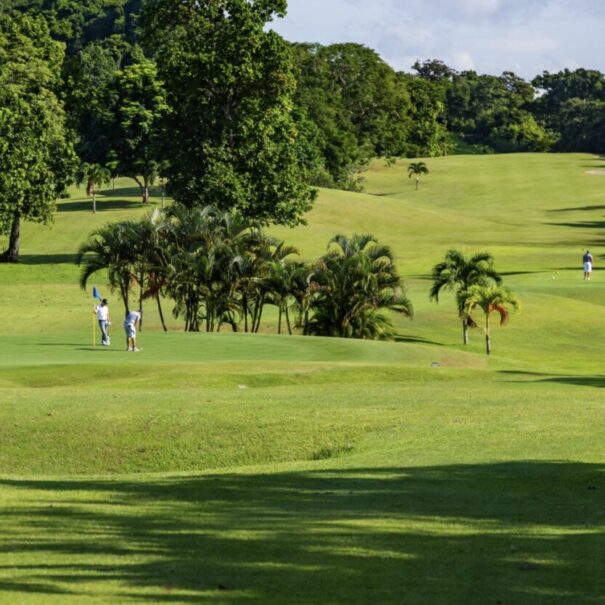-
CENTRAL AMERICA
-
CENTRAL AMERICA
Everything You Need
Central America puts an exclamation mark on both topographical and experiential diversity It is a string of seven countries that separates Mexico from Colombia, flanked by the Caribbean Sea to the east and the Pacific to the west. But Central America may as well be seven different worlds. Possibly more. Belize, El Salvador, Nicaragua, Costa Rica, Guatemala, Honduras and Panama—they are each bountifully blessed in tourist experiences, with the latter four nations also touting at least one of Central America’s Top 10 golf courses. Panama alone features four of the top 10, from the 4.5-star manicured luxury of the seaside Buenaventura Golf & Beach Resort to the raw, rugged, drop-dead-gorgeous views of Lucero Country Club, perched amid coffee plantations 3,600 feet above sea level in tropical highlands.
Want the castaway feeling of having a palm-studded island of white sands and translucent waters all to yourself? Just a two-hour drive from Panama City, you can catch a speedboat or sailing excursion to the nearby San Blas Islands of Panama. But when in Rome—or at least the Panamanian equivalent—you must visit the famed shortcut between the Atlantic and Pacific Oceans, the Panama Canal.
If you’d prefer to discover yourself—and others from around the globe—there’s the pulsating, lavish, hypnotic, spiritual nature of the Envision music, art and yoga festival in La Uvita de Osa, Costa Rica—a one-of-a-kind experience in a seaside jungle setting. Or perhaps you can learn the steps to the sensual Palo de Mayo dance in Nicaragua. Or, if your interests run a tad more exotic, check out the nightlife of the kaleidoscopic Treetanic Bar on Honduras’ Utila island, a labyrinth of dazzlingly decorated spaces with a treehouse at its core.


Seeking something more family-oriented? An eco-tour and ziplining through the rainforest and waterfalls of Costa Rica, or negotiating the Mistico Hanging Bridges in the shadow of the hulking Arenal Volcano might fit the bill. Just make sure to save energy for a tee time at La Iguana, with its 150+ species of birds and local wildlife providing the soundtrack.
Diving fanatics, meanwhile, can explore the famed undersea walls of Honduras’ Roatan island in the morning, then tee it up at The Black Pearl, another Top 10 layout, in the afternoon.
Not quite adventurous enough for you? Have you ever tried roasting marshmallows in a lava pit? It’s often on the agenda during guided tours through parts of the Central American Ring of Fire, a 900-mile-long stretch of volcanoes, cinder cones and lava domes along the Pacific coast. (It’s hard to beat lying on your stomach as you peak into the bubbling cauldron of Nicaragua’s Telica Volcano in the middle of the night.) Just save your energy for the jaw-dropping jungle wonder of Guacalito GC at Mukul Resort on the country’s stunning Emerald Coast.
As far as communication goes, while popular tourist destinations will almost always be able to cater to Spanish-challenged visitors, English is actually the primary language in Belize and the Caribbean coast of Honduras.
From an accessibility standpoint, travelers should carefully map out their itinerary. This is not a destination renowned for accommodating disabilities, and sidewalks can be treacherous. But higher-end hotels can typically be relied upon. And the Costa Rican capital of San José features several wheelchair-friendly amenities, including the new Universal trail at Manuel Antonio National Park, produced as part of the country’s Equal Opportunities Law, featuring 10 different sections with braille signage. Volcán Poás and Carara National Parks are similarly equipped. You can even tour Irazu Volcano (at 11,260 feet in elevation, remember to bring extra layers of clothing) and sample local cuisine at Mi Tierra Restaurant nearby, which is also wheelchair friendly, including an accessible companion-care restroom. And as far as getting around major tourist areas is concerned, the Association of Costa Rican Special Taxis offers a fleet of 40 wheelchair-accessible vans.
Costa Rica is also consistently ranked the safest country in Central America, with Panama close behind. The latter offers wheelchair-accessible guest rooms at major hotels, and several restaurant and other public bathrooms are accessible to those with limited mobility. But off the beaten path, things become less accommodating.
Regardless of your agenda, make sure to check the weather before you leave, as some of the more remote attractions can be inaccessible to all after heavy rains.

And remember to give thanks to Philippe Kahn. For in a remarkable region of the planet where it seems like every golf course is woven directly into an Eden — like tapestry — from mist-covered mountains to palm-studded beaches — you’ll be eternally grateful to the inventor of the camera phone!
Central America Packages
- Sorry, this product cannot be purchased.
